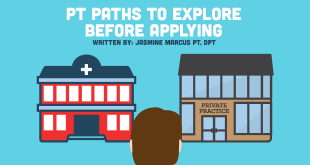During the last week of my third internship, the entire staff took new headshots for the office. I was told to get in line to have my photo taken, which I took as a sign they were thinking I could eventually work there.
Today, my picture hangs next to that of my former clinical instructor. That internship was part of a pattern. Each of the four places, with whom I completed a rotation, discussed job opportunities with me.
I was familiar with the company’s rules and culture, I knew most of the staff, and I knew what the patient population was like. The oft-repeated saying is true: an internship is basically a 10-week interview. So here’s how to ace the “interview” and land your first physical therapist job:
1. Do your homework
When something came up that I didn’t know or remember, I made sure to write it down in my notebook and look it up that night. Sometimes, my CIs gave me this homework, but other times I took it upon myself. For example, during my first internship, a patient mentioned that his son had Marfan’s syndrome. I hadn’t yet learned about it in school, and my CI said he didn’t remember much about it. Even though it wasn’t for our patient, I went home and did some research on the syndrome and how we would treat a patient who potentially had it.
2. Don’t be afraid to make mistakes
We’ve all looked at a goniometer wrong and read that someone had 60 degrees of knee flexion instead of 120. The important part is that you don’t make the same mistake twice. Admit that you messed up, and ask for help if you need it. After I flubbed a screen on a new evaluation, my now-boss gave me a book to read about doing better evals. I went home, read it, practiced on my husband and did a great eval the next day on a new patient. To this day the memory still embarrasses me. Fortunately, my boss was understanding and placed the emphasis on using the opportunity to learn and grow.
3. Take advantage of other viewpoints
If your CI has free time (no patients to treat) hang out with another staff member. Every PT practices differently, so it’s good to get a range of viewpoints. Similarly, you get to see different specialties in action. Throughout my internship, I was lucky enough to spend time with practitioners who specialized in TMJ and women’s health. The experiences sparked an interest in these new areas.
4. Spend time with other professions
While interning at a skilled nursing facility, my CI arranged for me to spend time with the nurses, certified nurses aides, medical doctors, occupational therapists and speech therapists who worked in the SNF. Seeing how other allied health members performed their jobs, first hand, allowed me to have a better understanding of how our jobs fit together.
5. Stay in touch
After my first internship ended I established social network connections with the staff and I continued that trend at each facility following. Aside from sending each other messages and sharing links, I also occasionally email or text my former coworkers to ask questions or share accomplishments.
These five, easy to incorporate tips, made it easy to reach out and ask for a job at my current clinic and it is extremely meaningful to have the support of this new community behind me.
 NewGradPhysicalTherapy.com The Largest Online Resource For New Grad Physical Therapists
NewGradPhysicalTherapy.com The Largest Online Resource For New Grad Physical Therapists



